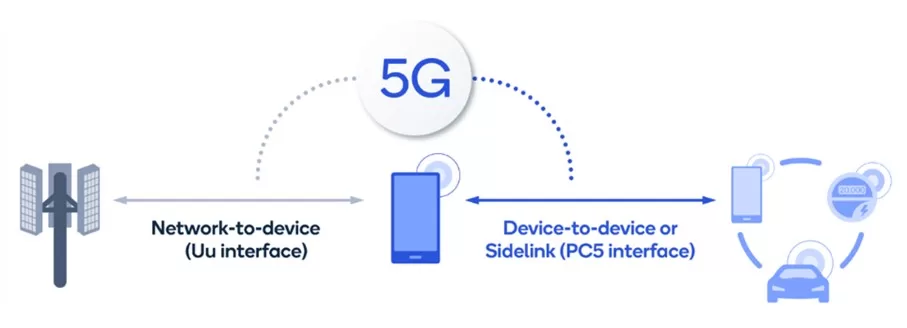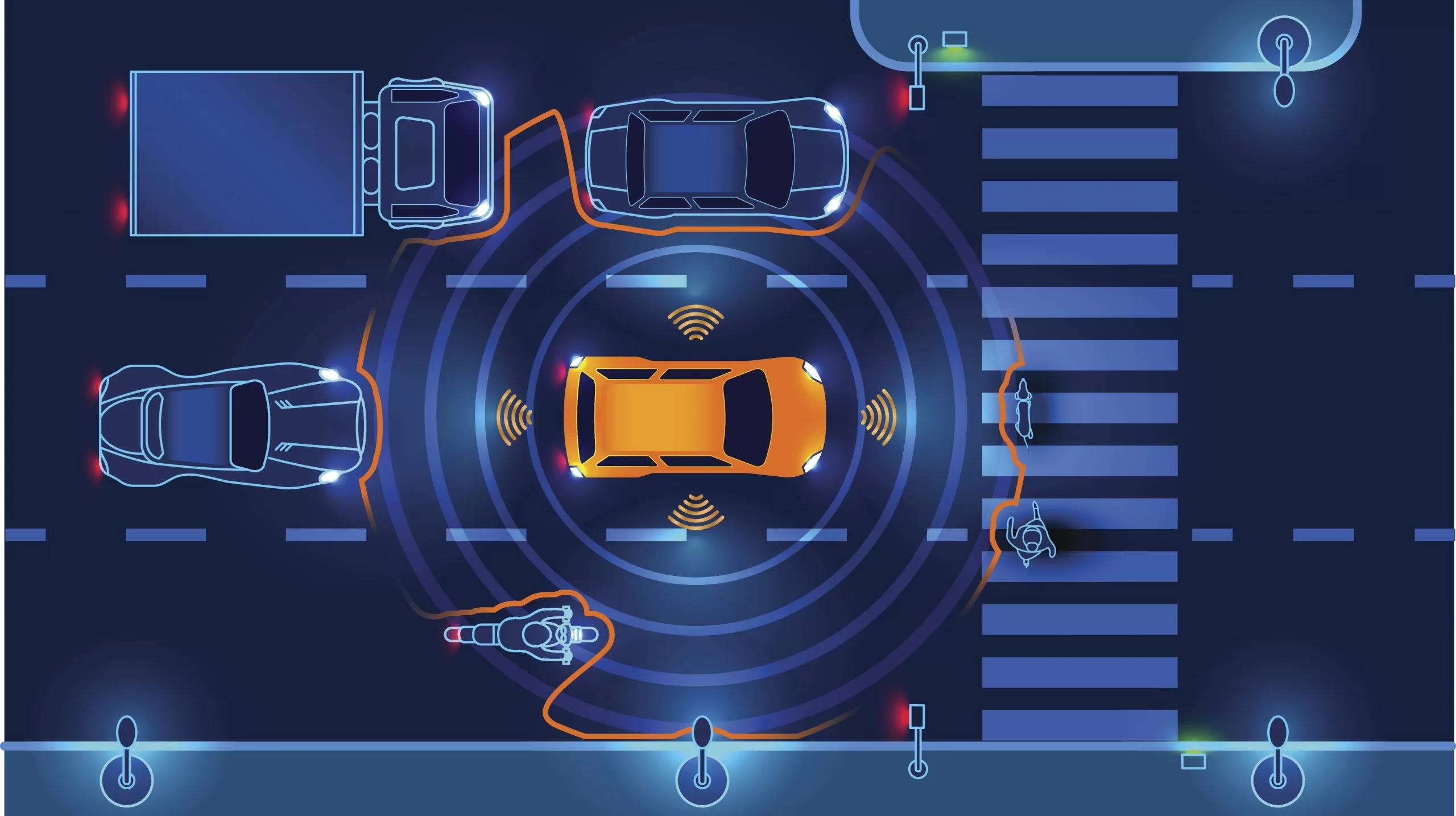Abstract
The Internet of Things (IoT) has become an essential part of today’s human lives. It provides various services in various domains such as large-scale industrial systems, transportation, power grid, agriculture, logistics, smart cities, and related public and private environments.
Sidelink technology in 5G is highlighted for its role in direct V2V communication, extended coverage, and flexibility. The article also outlines real-time connectivity challenges and emphasizes the pivotal role of IoT and 5G in shaping the future of connected transportation systems.
Introduction
The seamless integration of IoT into V2X scenarios empowers vehicles to share critical information in real-time, enhancing situational awareness and enabling rapid responses to potential hazards. This intersection of IoT and V2X is the driving force behind the smart transportation systems of the future.
The ability to gather and disseminate real-time data across a vast ecosystem of connected devices opens doors to innovative applications in smart traffic management, collision avoidance, and emergency services.
Over the course of several years, a series of progressive updates have been introduced to the realm of wireless communication. Notable milestones include the incorporation of Cellular Vehicle-to-Everything (C-V2X) sidelink support in 3GPP Release 14, followed by the introduction of 5G support in Release 15, among other noteworthy developments. However, the real game-changer emerged with the advent of 3GPP Release 16, which ushered in significant enhancements in IoT (Internet of Things) and marked a pivotal moment for 5G New Radio (NR) support. Now, we find ourselves at the juncture of 3GPP Release 17 and Release 18 (5G Advanced), both of which promise to revolutionize the concept of sidelink communication.
One primary objective of this evolutionary phase is to elevate the sidelink data rate. This will be achieved by incorporating Carrier Aggregation (CA) into sidelink communication, thereby expanding the scope of sidelink operation into unlicensed spectrum bands. Additionally, there is a concerted effort to enhance sidelink support within the frequency range 2 (FR2). Furthermore, 3GPP is actively investigating mechanisms to facilitate the coexistence of LTE V2X and NR V2X devices within the same frequency channel, ensuring efficient spectrum utilization and harmonious communication.
V2X Communication Protocols and Standards
Two primary categories of standards play an important role in V2X communication: Dedicated Short-Range Communication (DSRC) and Cellular technologies.
DSRC technology was meticulously crafted to facilitate data exchange among vehicles, Roadside Units (RSUs), and pedestrians, but within a relatively confined range (up to 100 meters). DSRC accomplishes this feat by employing mobile applications for pedestrians, on-board units for vehicles, and RSUs for roadside infrastructure support.
Nevertheless, DSRC confronts formidable challenges when striving to elevate the V2X communication system. These challenges stem from its conventional short-range communication capabilities, which grapple with issues related to reliability, efficiency, and latency, particularly in scenarios characterized by high traffic volumes [20]. Figure 3 illustrates a spectrum of short-range communication protocols and standards, reflecting the diversity within this domain.
Recognizing the constraints inherent to DSRC, cellular communication technologies have emerged as indispensable components of the V2X communication landscape. Cellular technologies step up performance by offering an expansive network coverage, increased capacity, and heightened productivity. Furthermore, they introduce the concept of intermediate stations that relay information to all nodes, thereby enhancing efficiency and reducing the communication system’s latency.
The incorporation of cellular technology into V2X introduces a range of communication standards, each tailored to suit specific cost considerations and deployment requirements [21]. These standards encompass the evolutionary stages of 2G, 3G, 4G (including LTE and LTE-Advanced), and the groundbreaking 5G.
IoT Protocols
In the context of V2X communication empowered by IoT features in 3GPP Release 16, the selection of appropriate IoT protocols and standards is paramount. These protocols and standards play a vital role in facilitating seamless and efficient communication among vehicles, infrastructure, and other entities within the V2X ecosystem. This section delves into the IoT protocols and standards used in V2X, focusing on their compatibility with 3GPP Release 16 IoT features.
- MQTT (Message Queuing Telemetry Transport)
MQTT, a lightweight publish-subscribe messaging protocol, is well-suited for V2X applications that require efficient data exchange with low overhead. It operates on a client-server model, allowing multiple clients (IoT devices) to publish messages to specific topics, which are then received by interested subscribers. MQTT’s simplicity and low latency make it suitable for real-time V2X communication.
- CoAP (Constrained Application Protocol)
CoAP is designed for resource-constrained IoT devices and is ideal for V2X scenarios where lightweight and efficient communication is essential. It is RESTful, making it easy to integrate with web-based services. CoAP is suitable for applications like vehicle tracking, remote control, and sensor data retrieval.
CoAP aligns with 3GPP Release 16 IoT features by offering a resource-efficient communication protocol. Its use of UDP reduces overhead, making it a good fit for V2X applications requiring low latency and high reliability.
- OneM2M (One Machine-to-Machine)
OneM2M is an international standard that provides a common framework for IoT deployments, ensuring interoperability and scalability. It offers a comprehensive architecture for IoT systems, including device management, security, and data exchange. OneM2M is valuable in V2X for its ability to unify diverse IoT devices and applications.
The choice of IoT protocols and standards is integral to the success of V2X communication in the era of 3GPP Release 16 IoT features. These protocols and standards empower V2X applications to achieve low latency, reliability, scalability, and interoperability, ushering in a new era of connected and intelligent transportation systems.
Expanding the connected intelligent edge with Sidelink
Sidelink stands as a fundamental element within the architecture of the 5G system, serving as the cornerstone for direct device-to-device communication, eliminating the need for intermediary base stations in data transmission and reception.

Its design embodies a wide spectrum of advantages, enriching the 5G system’s capabilities. Sidelink exhibits versatility by seamlessly operating across various spectrum configurations, including dedicated, in-band licensed, and unlicensed spectrums. This adaptability allows it to find applications in a myriad of scenarios and settings. Moreover, its compatibility with a diverse range of devices fosters a thriving ecosystem of use cases.
Sidelink technology plays a crucial role in enabling Vehicle-to-Everything (V2X) communication within the context of 5G networks. For instance:
- Direct V2V Communication: Sidelink operates in Device-to-Device (D2D) mode, allowing vehicles equipped with 5G-enabled radios to communicate directly with each other without the need for a cellular base station as an intermediary. This is achieved through the use of sidelink radio resources, which are part of the 5G New Radio (NR) standard.
- Extending Coverage: Through device-to-device communication and multi-hop mesh relays, it extends network coverage, especially beneficial for massive IoT deployments like smart meters.
- Spectrum Flexibility: Sidelink can operate in various spectrum configurations, including dedicated spectrum, in-band licensed spectrum, and unlicensed spectrum. This flexibility allows it to adapt to diverse deployment scenarios, from dedicated V2X networks to utilizing existing cellular spectrum for V2X communication.
- Sidelink Proximity Services (ProSe) is a key aspect of sidelink technology that enables direct communication between vehicles within close proximity. It operates in both licensed and unlicensed spectrum, providing a robust framework for V2V and V2X communication.
- Enhancing Ranging Accuracy: Sidelink contributes to improved positioning accuracy, even in challenging scenarios like densely populated urban areas and tunnels.
- Efficient Data Offload: It provides high-throughput data transfer capabilities to devices in close proximity, supporting data-intensive applications like gaming and seamless data backup.
In summary, sidelink emerges as a foundational component of the 5G landscape, introducing a wealth of capabilities that transcend traditional communication paradigms. Its adaptability and diverse applications make it a pivotal force in enabling efficient, direct device-to-device communication across a wide array of scenarios.
Real-Time Connectivity Challenges
While the IoT features introduced in 3GPP Release 16 bring substantial enhancements to Vehicle-to-Everything (V2X) communication, they also present unique challenges, particularly in the context of real-time connectivity. Addressing these challenges is crucial to ensure the reliability and effectiveness of V2X applications. Here, we delve into some of the real-time connectivity challenges:
- Low Latency Requirements
Many V2X applications, especially those related to road safety, demand extremely low latency. For instance, collision avoidance systems require near-instantaneous communication between vehicles to prevent accidents. Achieving such low latency consistently across diverse network conditions is a formidable challenge.
- Scalability
IoT devices are expected to proliferate in V2X scenarios, leading to massive scalability requirements. Ensuring that networks can handle the surge in device connections and data traffic without compromising performance is a significant challenge.
- Reliability and Resilience
V2X communication systems must operate with high reliability, especially in emergency situations. Ensuring that messages are delivered without disruption, even in congested or adverse network conditions, is a considerable challenge.
- Security
The interconnected nature of V2X communication systems makes them vulnerable to cyber threats. Ensuring the security and integrity of data exchanged among vehicles and infrastructure is a continuous challenge.
Advanced security protocols, including strong encryption, secure device onboarding, and authentication mechanisms, are essential to safeguard V2X communication. Regular security audits and updates are crucial to staying ahead of emerging threats.
- Standardization and Interoperability
V2X systems involve a multitude of devices and technologies. Ensuring seamless interoperability among diverse components is a challenge that can impact the overall effectiveness of the ecosystem.
Collaboration among industry stakeholders, standardization bodies, and regulatory authorities is crucial to establishing common protocols and standards that facilitate interoperability.
- Spectrum Allocation
Efficient spectrum allocation is essential for V2X communication. Effective spectrum management and allocation policies, guided by regulatory bodies, help ensure that V2X applications have access to the required spectrum resources without causing interference.
Conclusion
In conclusion, the integration of IoT into V2X scenarios enhances real-time data sharing in smart transportation systems. This synergy between IoT and V2X has evolved over several wireless communication updates.
3GPP Release 16 marked a new area for IoT and 5G NR support, setting the stage for 3GPP Release 17 with the sidelink that brings major improvements for IoT and V2X Communications.
Sidelink technology enables direct V2V communication, extends coverage, and supports various spectrums, enhancing V2X applications.
Challenges in real-time connectivity include low latency, scalability, reliability, security, standardization, interoperability, and efficient spectrum allocation. Overcoming these challenges is vital for connected and intelligent transportation systems.
References
- Kiela, M. Jurgo and R. Navickas, “Structure of V2X-IoT framework for ITS applications,” 2020 43rd International Conference on Telecommunications and Signal Processing (TSP), Milan, Italy, 2020, pp. 229-234, doi: 10.1109/TSP49548.2020.9163539.
- 3GPP TR 22.886, ”Study on enhancement of 3GPP Support for 5G V2X Services”, v15.1.0, Mar. 2017
- Malik Saadi, “5G Sidelink”, https://www.abiresearch.com/blogs/2022/11/08/5g-sidelink/

